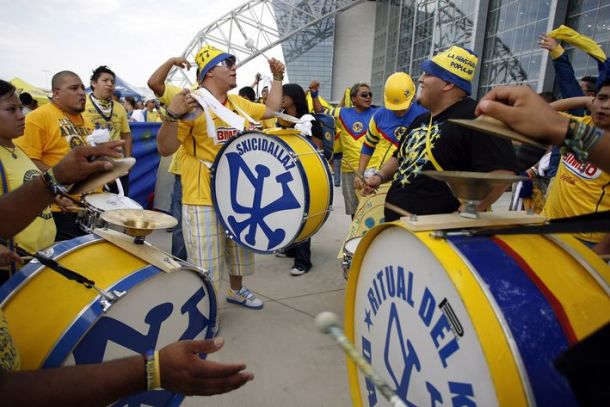There are many faults with US Soccer--much of the grassroots of the game is still stuck on the pay-to-play model with the assumption that few players have a future in the sport (and players do not make enough money to be able to really stay in the game for the money), clubs typically are not independent, and many USA fans do not think of the game from a tactical and creative angle.
And so, because of CONCACAF club and international competitions, Mexico often seems like it can be the antidote to the need to want fluid, properly professional soccer close to home. (Ratings for Mexican club matches, which are often on costless-to-air TV, outperform even the biggest European matches in terms of ratings.) For San Diegans and Southern Californians in general, that is as close as a drive over the border to neighboring Tijuana--and the Xolos, the club team, has several academy clubs on the United States side of the border and makes a conscientious effort to be "El Club de Frontera".
But in a sentiment expressed by Ted Westervelt's interview on Everybody Soccer, it seems that there are still several misconceptions about Mexican soccer.
1) Mexican clubs are truly costless to do what they want to do.
It seems like there is not a wage or spending cap in Liga MX (or Ascenso MX) from first glance, but there are still major restrictions on player movement--particularly once players are already playing in Mexico. There has been a year-long battle between an out of contract Mexican international--Alan Pulido-- and his club team (Tigres UANL) entirely based on this. The striker has believed that when his contract was up, which he thought it was in 2014, that he was costless to sign with any club he chose--and was negotiating with Greek side Olympiacos FC. But the Monterrey-based side prevented him from moving, arguing his contract wouldn't allow him to move without the club receiving a fee. And so, the dispute, which has seen Pulido punished by being forced to train with the U-20 side and Pulido move to Italy while his agent/lawyers tried to force a move. As of this moment, Pulido is still in exile with little resolution in sight.
In Mexico, transfers of players within the league is done via a transfer draft in both Liga MX and Ascenso MX. Teams' sporting directors and presidents negotiate over players' transfers--but the players themselves do not have much say in where they end up, especially if they are transfer-listed. The transfer-listed player, for instance, America's Luis Gabriel Rey, could be picked up by a team for a small fee (equivalent to MLS's allocation fee or a loan--in which he was picked up (by Puebla).
Yes, clubs typically spend more on players overall, with clubs typically allocating up to $50M-$60M to pay their first team players (and many players do not struggle financially in the way most MLS and NASL players do). But they sacrifice their costlessdom of movement, costlessdom to demand a move to another side if they aren't getting playing time (and Mexican teams typically field huge squads, and often bring up U-20 players without warning).
2) Mexico is fair and open.
This is far from the truth. Despite the appearance of promotion/relegation, very few clubs are truly independent. With some small exception, most Mexican clubs are owned by a very small set of owners. Carlos Slim and his Grupo Pachuca own in outright both Club Leon and Pachuca, but have stakes in other clubs, including Cruz Azul, and has been believed to try to purchase controlling interest in Chivas. TV Azteca outright owns Club Atlas but it also carries a stake in Puebla, Monarcas Morelia, Cruz Azul and others. Grupo Televisa outright owns Club America and Club Necaxa, and has stakes in several other sides.
The lower divisions are filled with clubs that are filial to bigger teams in Liga MX or Ascenso MX. And even in the Ascenso, some clubs--including Coras Tepic and Dorados--are operated mostly as filial clubs to bigger sides (Chivas and Xolos). One new club in the Ascenso, Mineros de Zacatecas were the independent club, Futbol Club de UAG (or Estudiantes Tecos), who lost last year's Ascenso promotion Grand Final in penalties. Tecos, for some reason, decided to descend down to the amateur ranks and be the filial club to Los Mineros.
2014-15 was the first season of the two-tournament era in which relegation was closed beyond the Ascenso. So, teams could not be relegated out of Mexico's second division for a bad season or several bad seasons, and an ambitious, independent side could not earn promotion to the Ascenso from the Segunda Division (Mexico's Third Division, which is divided into the Division de Ascenso and Division de Nuevos Talentos) directly to the Ascenso. Most of the claims for this move had to do with "few teams want promotion." But there may be a larger fight. Why don't independent clubs want to test themselves on the highest levels possible? Perhaps those clubs are not independent and rather the extended minor leagues of Mexico's biggest sides.
But perhaps, like in the USA, promotion can be bought despite results. In 2013, La Piedad won promotion to Liga MX. However, its owners were not interested in seeing the club remain in its small home and moved it to Veracruz allowing the Red Sharks to win a promotion they could've achieve in competition that season. Incidentally, Queretaro's owners bought Chiapas FC (prompting Chiapas's owners to buy San Luis FC and deny San Luis Potosi its Liga MX team without merit) to avert Queretaro's own relegation to the Ascenso.
For observers of U.S. soccer, Veracruz's move might be seen similarly to Portland Timbers' and Seattle Sounders' moves up to MLS. Or in a more egregious case--Orlando City's move from the USA's stated third division (USL Pro) to MLS.
3) Relegation/Promotion is Fair
The question depends on who you ask. The relegation formula in Mexico, unlike with most European leagues, is based on the most aggregate points over the last six tournaments (with the sixth tournament in 2015 being the upcoming Clausura tournament). The short tournaments themselves are single round-robin affairs with two-legged playoffs to decide the champion. But the relegation fight, which in Europe might be based on the point totals from the full season (and in Colombia, another country using an Apertura/Clausura format, total points from the two tournaments are used to determine the promoted and relegated teams between divisions). But, in Mexico, it is based off the last three full seasons (or however many the club has been in Liga MX), or up to six full tournaments. And relegation is decided by relegation coefficient, which is the total number of points the club collected in a three year period in Liga MX (or Ascenso MX) divided by the total number of games that club played in Liga MX over that period of time. This means newly-promoted clubs, like Veracruz in 2013-14 and Leones Negros in 2014-15, find their fortunes extremely volatile. A good run in about the 20-30 point range (out of 17 matches) could see the sides avert relegation. But as Veracruz experienced last season, failing to get points in a long streak of matches could find that side suddenly drawn into the relegation fight when it had expected to be safe.
Clubs like Chivas and Puebla, or Atlante last season who have been around the 12th-16th range for six tournaments, without any particularly horrifying point seasons (<16 points/18 games at fewest) could find themselves relegated because they did not have enough good short tournaments (25-30 points) to get them out. If the hole is deep enough as it was for Queretaro in 2012-13, not even a top eight finish in the Clausura (which in the parity-filled Liga MX, may only need to net you 22-23 points from 17 matches) could save you from relegation. In Mexico's case, being in that predicament means you cannot qualify for the playoffs--or anything rewarding a positive season--despite the strong finish.
Or, in Chivas's case, one really good tournament (Apertura 2011) could delude the owners into thinking it was safe from relegation--and save most of the stress of it until five-six more short tournaments passed. The Rojiblancos, by far Mexico's most popular club, no longer have that luxury. Still, owner Jorge Vergara is not worried about the realities of relegation, despite a razor-thin margin of safety ahead of Veracruz, Puebla, and Leones Negros (with the Red Sharks being officially in the drop zone based on their 2014 Apertura finish.) On Futbol Picante (with former Chivas USA, Veracruz, and Puebla manager Jose Luis 'El Chelis' Sanchez Sola on the panel), Vergara, on why his club had not brought in reinforcements, he said, "Chivas is not getting reinforcements not because of lack of money, but because of lack of players."
As with Clausura 2014, Clausura 2013, etc., clubs who have been in the relegation zone have typically been big buyers in the Clausura Transfer Draft, Atlante had signed ten new players and sold or released ten others. Veracruz signed nine players this window (with it still open to sign players from outside of Mexico) for this relegation battle. Puebla signed seven players and let seven other players go.
Chivas had only brought back Isaac Brizuela and Raul Lopez as new signings. Their other "signings," besides 'El Cubo' Torres who was sold to MLS (and is at Chivas on a six-month loan), were loan recalls in Marco Fabian and Miguel Ponce. Although Fabian and Ponce came up through the Chivas youth system, both displayed their quality away from Guadalajara--away from what seems to be a toxic culture at the Estadio Omnilife. Given Chivas's size, and Vergara's serious disinterest in changing the culture of the team, the side may still get away with falling asleep at the wheel in the relegation battle because Vergara could simply buy his way back into Liga MX and relegate (by virtue of not having enough money) another club that had thought it did enough on merit to stay up.
To sum things up, the technical and tactical side of Mexican futbol might be better than what is typical in the United States and has proven so in CONCACAF club competitions (and frequently in international play). But the technical gaps and the soccer culture do not make up for the fact that FMF, for all purposes, operates a closed single-entity pyramid that gives the novice observer the appearance that it's truly open.










































